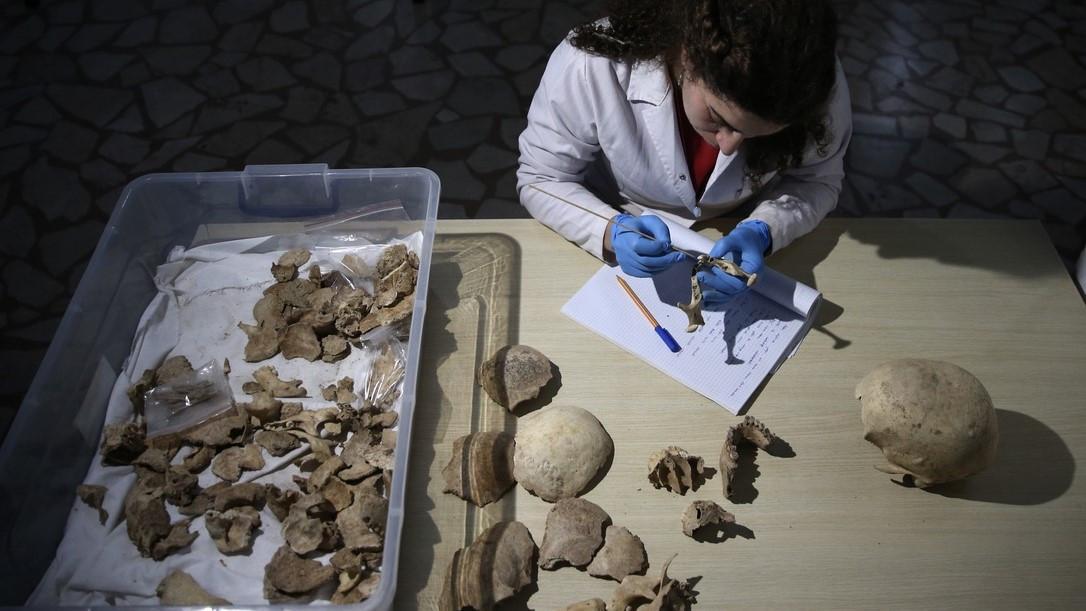
Ongoing archaeological excavations at Hisardere in the northwestern province of Bursa, which served as a necropolis from the 2nd to the late 5th century during the Roman and Early Byzantine periods, are revealing significant finds. The site is set to be transformed into a necropark, where casts of the ornate and decorative sarcophagi uncovered in the area will be displayed.
Excavations, led by a team from Dokuz Eylül University, began in 2018 in the area and still continue.
The archaeological work, conducted on a 10-hectare site that was once an olive grove, uncovered relief and decorative sarcophagi, terracotta (red-fired clay) roofed chamber tombs adorned with frescoes unique to İznik, hypogea (burial chambers built with vaulted ceilings beneath the ground), burial gifts, skeletons and a basilica with mosaic flooring.
The skeletons found are being studied and documented by an anthropologist. Other artifacts are on display at the Hisardere Hall in the İznik Museum.
When the work is done, the area will be turned into a necropark where visitors can learn about burial traditions and the typology of tombs from the era.
Professor Aygün Ekin Meriç, the scientific coordinator of the excavation and a faculty member of the Department of Archaeology at Dokuz Eylül University, said that sarcophagi had been discovered during illegal excavations in the area since 1989. The area was expropriated in 2017, and scientific excavations began in 2019.
Meriç explained that the excavation revealed sarcophagi named after figures like "Gregorios," "Gods," "Antigonos" and "Nigrenie and her daughter Astyrist," as well as two with reliefs of Eros, and terracotta-plated chamber tombs dating to the third century.
“We came across rectangular tombs covered with six concave terracotta plates, with floors paved with brick tiles and frescoes depicting paradise gardens on the walls. We discovered that these were family tombs for up to 14 people, which is a burial tradition unique to İznik, with no similar examples elsewhere,” said Meriç.
He also noted that the sarcophagi and remains were wrapped in fabric made of cotton and linen, which has provided valuable opportunities for the research of the bones.
Merit stated that they had identified the mosaic floor as belonging to a basilica from the fifth century, and discovered that this basilica was the largest in İznik.
“It’s a very large basilica, built directly on top of the necropolis, but it did not harm the sarcophagi. Later, it was used as a cemetery church. We have confirmed that this necropolis functioned from the 2nd to the late 5th century. We’ve covered the mosaic with sand for now, but we see that it extends eastward and westward. We plan to uncover all of it as conditions allow.”
Meriç also said that they discovered hypogea, which are regular burial chambers for several people reached by steps, and simpler stone-slab tombs. He emphasized that they had successfully uncovered the burial typology without altering it.
“This necropolis is an important example of a burial site in the Bithynia Region. We are uncovering this area now, and starting this year, as part of the Culture and Tourism Ministry’s of Heritage to the Future Project, we will continue work with more substantial budgets and over a longer period. This will allow us to complete the excavation and conservation more quickly,” he said.
Meriç expressed their goal of completing the excavation of the entire 10-hectare area and opening it as an open-air necropark for visitors.
He explained that the burial traditions in the necropolis reflected the wealth of the individuals, from the simplest to the more elaborate tombs, with frescoed chamber tombs and marble sarcophagi.
“You will be able to see all kinds of sarcophagi, including those with intricate reliefs, as well as simpler ones. We can see the entire burial tradition of people who lived during the Roman Empire and Early Byzantine periods here. We will create molds of all the sarcophagi, which will be displayed in their original locations. Information about the individuals buried will also be provided. We want to create a necropark that will present all of this data, and we dream of giving İznik such a necropolis,” he said.